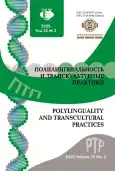Street Art or Successful Commercial Projects? New Functions of the Symbolic Usage of Language in Linguistic Landscapes of Russian Cities
- Autores: Shcherbakov O.V.1
-
Afiliações:
- Lomonosov Moscow State University
- Edição: Volume 22, Nº 2 (2025)
- Páginas: 290-302
- Seção: LINGUOCULTURE. LANGUAGE IN PROCESS
- URL: https://journal-vniispk.ru/2618-897X/article/view/326848
- DOI: https://doi.org/10.22363/2618-897X-2025-22-2-290-302
- EDN: https://elibrary.ru/PPDYET
- ID: 326848
Citar
Texto integral
Resumo
The urban linguistic landscape is a dynamically developing object of study in linguistics, sociology, economics and marketing. Its texts are able not only to transmit information, but also to serve a decorative - or symbolic - function. The article examines five creative projects that place texts with symbolic meanings in urban space. The author analyses the texts, identifying their possible functions and the reasons for the high social demand for such projects. Three functions are proposed for the texts in question: psychotherapeutic, marketing, and educational, while the marketing one is often implemented covertly. The article provides a comprehensive analysis of each project and concludes that their popularity among urban residents is linked to the high level of stress in the current socio-economic context and feeling of loneliness in large cities.
Palavras-chave
Sobre autores
Oleg Shcherbakov
Lomonosov Moscow State University
Autor responsável pela correspondência
Email: shcherbakov.science@yandex.ru
ORCID ID: 0000-0003-3539-7178
PhD student at the Faculty of Foreign Languages and Area Studies
1 Leninskie Gory, Moscow, 119234, Russian FederationBibliografia
- Gorter, D., and J. Cenoz. 2024. A Panorama of Linguistic Landscape Studies. Bristol: Multi-lingual Matters. https://doi.org/10.21832/9781800417151
- Shohamy, E. 2019. “Linguistic landscape after a decade: An overview of themes, debates and future directions. Expanding the Linguistic Landscape: Linguistic Diversity, Multimodality and the Use of Space as a Semiotic Resource.” Bristol: Multilingual Matters, 300 p, pp. 25-37. https://doi.org/10.21832/9781788922166-004
- Shohamy, E., and E. Ben-Rafael. 2015. “Introduction: Linguistic Landscape, a new journal.” Linguistic Landscape, vol. 1, pp. 1-5. https://doi.org/10.1075/ll.1.1-2
- Ivanov, V.V. 2023. “Developing theoretical principles of linguistic landscape research in the context of urban multilingualism.” Polylinguality and Transcultural Practices, vol. 20, no. 3, pp. 426-435. (In Russ.). https://doi.org/10.22363/2312-8127-2023-20-3-426-435 EDN: XFUYJR
- Landry, R., and R. Bourhis. 1997. “Linguistics Landscapes and Ethnolinguistic Vitality: An Empirical Study”. Journal of Language and Social Psychology, vol. 16, no. 1, pp. 23-49 https://doi.org/10.1177/0261927X970161002
- Kelly-Holmes, H. 2020. “The Linguistic Business of Marketing”. The Business of Words: Wordsmiths, Linguists, and Other Language Workers. C. Thurlow (ed.). London and New York: Routledge, pp. 36-50.
- Wee, L. 2003. “Linguistic instrumentalism in Singapore.” Journal of Multilingual and Multicultural Development, vol. 24, no. 3, pp. 211-224. https://doi.org/10.1080/01434630308666499
- House, J. 2003. “English as a lingua franca: A threat to multilingualism?” Journal of Socio-linguistics, vol. 7, no. 4, pp. 556-578. https://doi.org/10.1111/j.1467-9841.2003.00242.x EDN: EUIHCB
- Liu, Jingpeng. 2019. “Linguistic Landscape: Styding and Analyzing Translation from Russian into Chinese in Russian Cities.” Moscow University Translation Studies Bulletin, no. 2, pp. 121-129. Print (in Russ.)
- Baranova, V., and K. Fedorova. 2020. “Growing Visibility: Migration and Transformations in Saint Petersburg’s Linguistic Landscape.” Laboratorium: Russian Review of Social Research, no. 12, no. 1, pp. 48-80. (In Russ.). Print (in Russ) https://doi.org/10.25285/2078-1938-2020-12-1-48-80 EDN: OPGCGF
- Boyne, R. 1998. Angels in the Archive: Lines into the Future in the Work of Jacques Derrida and Michel Serres. Time and Value. Oxford: Blackwell. Pp. 48-64.
- Gell, A. 1998. Art and Agency. Oxford: Oxford University Press. Print.
- De Burgh-Woodman, H., and J. Brace-Govan. 2022. “Vista, vision and visual consumption from the Age of Enlightenment.” Marketing Theory, vol. 10, no. 2, pp. 173-191. https://doi.org/10.1177/147059311036
- Maly, I. 2019. “Hipsterification and capitalism: A digital ethnographic linguistic landscape analysis of Ghent.” In Tilburg Papers in Culture Studies, 2 Dec 2024. https://research.tilburguniversity.edu/en/publications/hipsterification-and-capitalism-a-digital-ethnographic-linguistic
- Pine II, B.J., and J.H. Gilmore. 1999. The Experience Economy: Work is Theatre and Every Business a Stage. Boston: Harvard Business School Press. Print.
- Leimgruber, J.R.E. 2020. “Global multilingualism, local bilingualism, official monolingualism: The linguistic landscape of Montreal’s St. Catherine Street.” International Journal of Bilingual Education and Bilingualism, vol. 12, no. 6, pp. 708-723. https://doi.org/10.1080/13670050.2017.1401974
Arquivos suplementares









